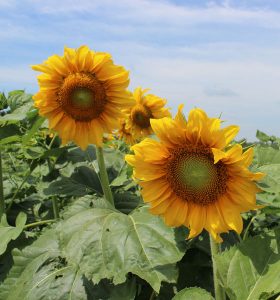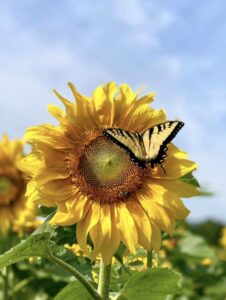Bloom Where You are Planted
Bloom Where You are Planted
Sunflowers have a long history tied back to Native Americans who grew sunflowers for flour, food, and oil. Belonging to the family of plants called Asters, sunflowers are annuals, around for one growing season, however, will reseed themselves plentifully. The sunflower is considered the world’s largest flower with average plants reaching over 5 feet tall… Read More »

The elegant sunflower is not only beautiful to look at it also has many benefits. The plants are soil cleansing and balancing, their colorful blooms attract pollinators, and there are uses for the seeds, petals, stems, and roots. Seeds are a favored sunflower seed snack, famous with baseball players, rich in vitamin E and other nutrients. The seeds are ground into gluten-free flour and a cooking oil that is low in saturated fat. Seeds can be roasted into a coffee substitute with the stems made into fiber for paper and fabrics. The petals are useful as dyes for fabric and fodder for livestock. The roots of the sunflower run deep and are known for sequestering residual nitrogen while cycling nutrients back into the soil. These lengthy roots also help with prevention of soil erosion and compaction.
Sunny and Bright
The sunflower attracts vital pollinators to any garden and farm cropland. The bright hues, appealing tall height, and large
It is said amongst some Farmers’ folklore that sunflowers got planted near or among corn crops to divert the birds’ attention from corn plants to the sunflower seeds instead, a living scarecrow perhaps. Farmers favor growing sunflower crops for their durability and low maintenance. They are highly drought tolerant due to their efficiency in using water and are great crop cover. Their large, thick stalks are (mostly) weather-resistant and require minimal tending by Farmers so they can focus their valuable energy on other crops.
A great way to truly enjoy the beauty of sunflowers is to visit our farm and learn more about our sunflowers on our website. We grow 12 acres of sunflowers in season which equates to approximately 10 fields. We carve a trail in the sea of yellow for guests to create an up-close and personal vantage point. Utilizing a farming technique called succession planting means we seed sunflower crops at intervals to maintain a consistent supply throughout the season. We typically plant and harvest seven different sunflower fields throughout the season to ensure our guests can enjoy the Blooming Giant Sunflower Trail throughout the pick-your-own season and experience flowers and heads for harvest. We also host Sunflower & Summer Harvest nights which take place at sunset, a beautiful time to visit the Blooming Giants and pick your own fields. We are currently hosting a sunflower photo contest to highlight the beautiful images captured on our farm. You can enter your photo from this year’s visit here.
Are you interested in learning more about harvesting sunflower seeds? You can check out our video on how easy it is to harvest sunflower seeds on YouTube. Have you ever eaten grilled sunflowers? Find our video on this trendy new way to eat sunflower heads here.







